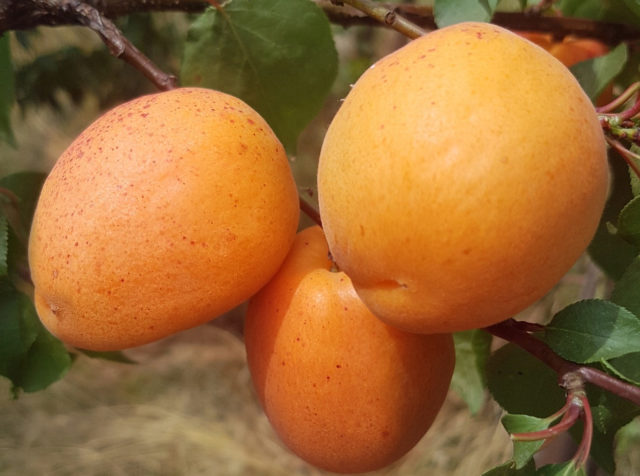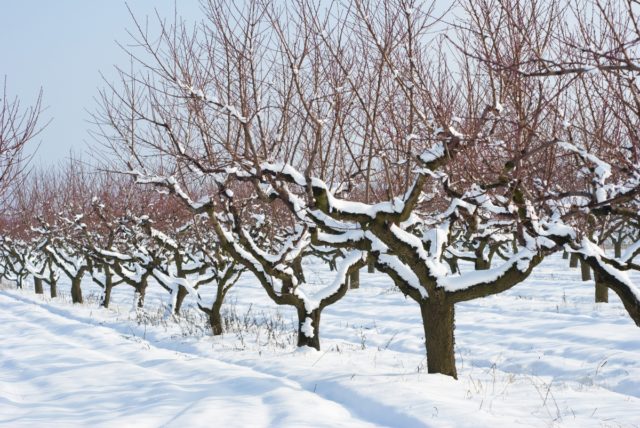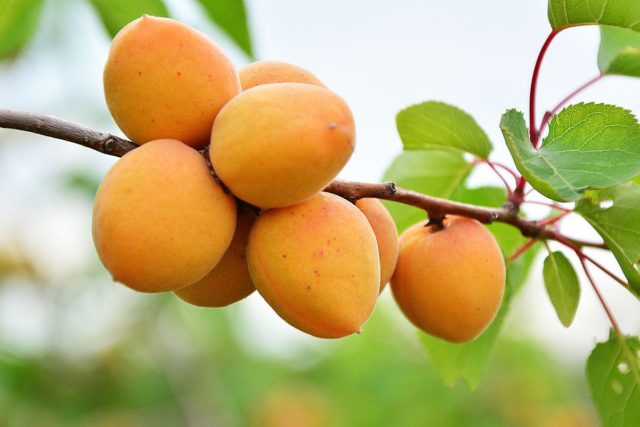Content
The description of the Amur apricot variety proves that this is one of the few crop species that can grow, bear fruit and develop safely in the Middle Belt, Siberia, the Far Eastern Territory and the Urals. Despite the fact that the tree is considered to be thermophilic, thanks to the wonders of selection, the gardeners of these places have the opportunity to grow it. "Cupid" is not afraid of frost, drought and disease resistant. The variety has been tested over the years and has earned many positive reviews from summer residents.
Breeding history
The "Amur early" apricot appeared in 1949 as a result of the labors of breeders from the Far Eastern Agricultural Research Institute. The authors of the variety are V. A. Marusich and G. T. Kazmin. When breeding for pollination, they used the frost-resistant apricot "Best Michurinskiy" (Luchshii Michurinskii) and a mixture of pollen from the southern varieties "Royal" (Regius), "Alexander mane", "Krasnoschekiy" and "Overinsky early ripening" ( Overinskii praecoquis). Successful work allowed the hybrid to be included in the State Register of Varietal Crops (1979). In 1991, the "Amurskiy Early" was accepted for state testing.

Amur early apricot is recommended to grow in the Central regions and the Far East
Description of the Amur apricot variety
The hybrid is growing very slowly. It differs from other apricot trees in compact dimensions: width 350 cm, height 300 cm. The trunk of the tree is half-stem, resistant to burns and podoprevanie. The bark is smooth, with large lenticels. Branches from the ground are located at a distance of 100 cm, grow almost at an angle of 900.
Shoots of "Cupid" at a young age have a brown color, develop at a moderate pace, as they grow older, they acquire a green tint, become smooth.
Judging by the photo, the foliage of the Amur apricot is large, there are many of them. Dark green on the front side, slightly whitish on the inside. The kidneys are arranged in 3 pieces.
In mid-May, the tree is covered with large red buds, from which medium-sized fruits weighing up to 35 g are formed. The shape of ripe apricots is rounded with a deep base, the tip is slightly elongated. The seam on the surface of the fruit is small, the skin is uneven, strong, does not separate from the pulp, and has a bright yellow color. The stone is small, smooth, well behind the slightly crispy pulp. The taste of the fruit, which can be used for different purposes, is sweet and sour, with an average juiciness. The shelf life is 14 days.

With frequent precipitation, Amur apricot acquires a more sour taste
Characteristics
This apricot variety has excellent characteristics. "Cupid" is able to withstand severe winters and droughts. The ripening period is average, annually brings a lot of harvest, resists the main ailments of stone fruit crops.
Drought tolerance
"Amur" is a variety with high drought resistance.Even with rare precipitation and lack of moisture, its branches and leaves do not die off, the ovaries are preserved, an increase appears. But the culture perceives excess moisture poorly, which is why it is not recommended to plant it in a lowland and where there is stagnation of moisture.
Frost resistance of Amur early apricot
The variety is distinguished by its exceptional resistance to frost, and is able to withstand temperatures as low as -38 degrees. Sometimes the tips of young growths can freeze on a tree, but this does not adversely affect its development and productivity. Even during a harsh winter, the branches and trunk of the apricot do not suffer and with the onset of warmth all the growths restore their strength.

Excellent frost resistance makes the variety ideal for cultivation in the Far East region.
Pollination, flowering period and ripening times
For a good harvest, the Ussuri apricot with partially self-fertilized pollination must have other pollinators nearby. It is better that several varieties of apricot trees grow nearby, which bloom at the same time as Amur, and also have a high resistance to cold, for example:
- Academician (Academicus).
- Khabarovsk (Habarovskiy).
- Kigichensky (Chechenski).
The tree begins to bloom from mid-May. Fruit ripening occurs closer to the second half of August.
Productivity, fruiting
The first fruits on the Amur tree begin to appear at the age of three. Good fruiting occurs after 5 years of growth. Each year, one tree produces 35 to 45 kg of fruit.

Amur's harvest remains high for many years
Scope of the fruit
Amur fruits are suitable for making jam, compote and preserves. They can be consumed both fresh and dried. Taste qualities of apricots according to the assessment of tasters - 3.5 points, the content of malic acid, sugar and dry matter - 2.2; 12.3 and 15.5%. Fruit transportability is good.
Disease and pest resistance
The hybrid has a high immunity to clasterosporia and fungal infections. Moderately resistant to moniliosis. If not properly cared for, it can be attacked by insects.
Advantages and disadvantages
The main and most important advantage of the Amur apricot is its high winter hardiness. Also, the culture has:
- drought resistance;
- stable and abundant yield;
- confronting many diseases;
- commercial qualities.
As for the shortcomings of culture, summer residents note the following:
- instability to abundant waters;
- low sugar content;
- small fruit size.
Landing features
It is necessary to plant Amur apricot in accordance with all the rules. It is important to adhere to the deadlines, find the right place and planting material, follow the recommendations for the selection of neighbors.
Recommended timing
It is recommended to plant an apricot tree of the Amur variety in the spring, so that its root system is as strong as possible by winter. This rule does not apply to the southern regions, where planting can be performed in the fall.
Choosing the right place
The plot for a fruit tree must be reliably protected from wind and drafts, and be in the sun. The best place for a garden bed will be a hill with a groundwater level of about 250 cm, where moisture does not stagnate. The primer should be slightly alkaline or neutral.

Optimum soil acidity for apricot "Amur" - from 6 to 7.5 pH
What crops can and cannot be planted next to an apricot
When planting a tree, you need to take care that a pollinator grows next to it. If this is not available, then you will have to plant one or more seedlings of apricots of a different variety nearby, you must not forget that the roots of "Cupid" grow greatly in width.
You can not plant the Amur early in areas where cherries, sweet cherries, peaches, plums and other stone fruits previously grew.Also, the culture does not like the neighborhood with trees, especially with a nut and an apple tree. It is undesirable to plant it near fruit bushes (except for dogwood).
Selection and preparation of planting material
When choosing Amur apricot seedlings, it is better to give preference to those that are sold in nurseries or specialized garden stores. Ideally, the plant should be 12-24 months old, with well-developed moisturized roots. In order for a young apricot to take root better, it is soaked in water for a couple of days before planting in the ground.
Landing algorithm
When planting several seedlings, they can be laid in a row, keeping a distance of 3-4 m. Planting holes should be prepared in the fall. They should have a size of 80 x 80 x 80. If the soil is clay, then it is advisable to pour crushed stone or sand on the bottom of the holes. Together with the top layer of soil, mineral fertilizing, humus and ash must be added to the hole. After planting, water and mulch the plant abundantly.
Follow-up care of the culture
The Amur apricot tree needs to be properly watered. The plant tolerates drought well, but for abundant fruiting, moisture should not be neglected at the time of flowering, vegetation and 2 weeks before harvesting. Before wintering, the culture, and especially its roots, must be watered abundantly so that they do not freeze. During the season, Amur is fed several times:
- In spring (before and after flowering) - nitrogen-containing fertilizers (manure, urea, saltpeter).
- In summer - foliar dressing (June - nitrogenous fertilizers, July - phosphoric and potash fertilizers).
After harvesting, it is useful to fertilize the tree with wood ash and chalk.
Before the onset of sap flow, the apricot should be cut off.

An oversupply of fertilizers, like their deficit, can have a bad effect on the development of a tree.
Diseases and pests
Apricot "Cupid" is resistant to fungal diseases. He is not affected by stone fruit disease - clasterosporium disease. It is noteworthy that the variety has an average resistance to moniliosis and is able to become infected with it only in rainy weather.
The culture can be susceptible to invasion by such pests as the moth, aphid, leafworm and hawthorn butterfly.
Conclusion
The description of the Amur apricot variety confirms that it is excellent for growing in areas with unstable weather conditions. The culture bears many fruits and tolerates wintering well. In care, apricot is unpretentious, the main thing is to plant it away from other trees and take care of pollinating varieties.
Reviews of summer residents about the Amur apricot variety






